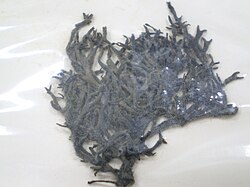| Ishigeales | |
|---|---|
 | |
| Scientific classification | |
| Domain: | Eukaryota |
| Clade: | Diaphoretickes |
| Clade: | SAR |
| Clade: | Stramenopiles |
| Phylum: | Gyrista |
| Subphylum: | Ochrophytina |
| Class: | Phaeophyceae |
| Subclass: | Ishigeophycidae Silberfeld, Rousseau & Reviers 2014 |
| Order: | Ishigeales Cho & Boo 2004 [1] |
| Families and unplaced genera | |
Ishigeales is an order of brown algae. It includes two families, Ishigeaceae and Petrodermataceae. The genus Diplura is also included, but not placed to family. [2]